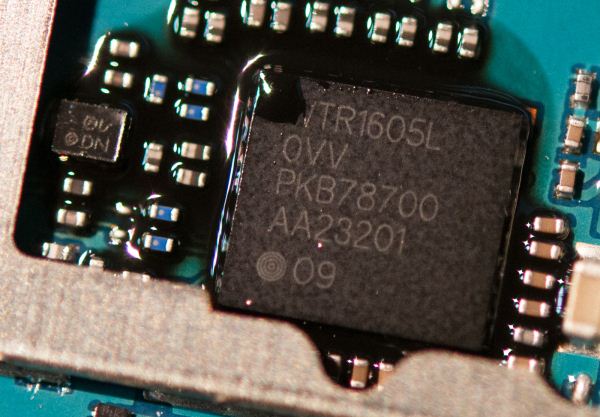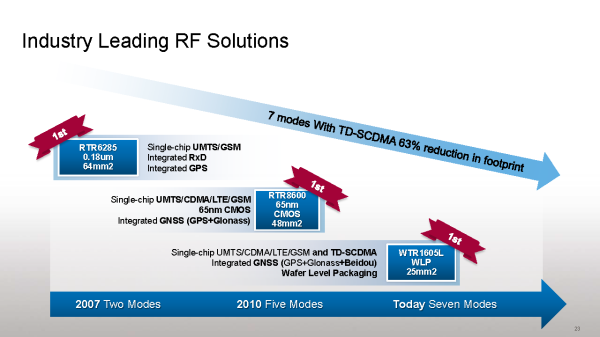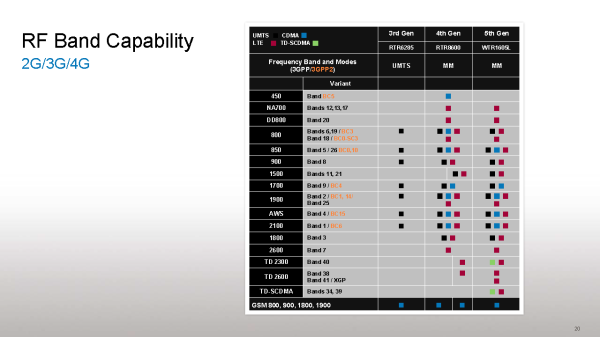The State of Qualcomm's Modems - WTR1605 and MDM9x25
by Brian Klug on January 4, 2013 9:48 PM ESTQualcomm's New Flagship Transceiver - WTR1605
The big new news information disclosure from Qualcomm relates to the capabilities and specifications of their new flagship transceiver, WTR1605 and how it compares to the previous generation, RTR8600. There are a number of new additions, but at a high level it boils down to different packaging (wafer level instead of plastic), inclusion of support for more primary receive bands (7 instead of 5), and support for one more GNSS constellation (the addition of the Chinese system, Beidou) over the previous generation. WTR1605 comes in two flavors, with WTR1605L including L for LTE. The first character in the name indicates package type, which is now wafer-level (hence the W) instead of a plastic, which Qualcomm tells me it can now inspect and test just as effectively as the plastic packaged previous generations. This allows the overall size of WTR1605L to be smaller in spite of it still being fabricated on a 65nm RF CMOS process (there was some previous documentation which suggested that WTR1605L was 28nm RF CMOS, this is not the case).
As a deviation, I also enquired whether we’ll see transceiver ever make it back inside the baseband package, similar to how MDM6x00 was a combination of baseband and transceiver in one single package. Other baseband manufacturers also have sold combination baseband and transceiver parts before, for example LG’s L2000 LTE chipset is a combo part. I originally suspected that this move back to discrete was done to decouple the two roadmaps (since we’ve seen MDM9x15 originally ship with RTR8600 and only now have seen phones with WTR1605L inside), but it turns out the reason is both the multiplicative effect of yields when combining multiple devices into one package (essentially cost), and that the overall system size is smaller with discrete wafer level packages for transceiver.
| RF Ports Comparison | |||||||
|
RTR6285 (3rd Gen) |
RTR8600 (4th Gen) |
WTR1605(L) (5th Gen) |
|||||
| Package Size, Type, Geometry |
64 mm^2, Plastic 0.18µm RF CMOS |
48 mm^2, Plastic 65nm RF CMOS |
25 mm^2, Wafer-Level 65nm RF CMOS |
||||
| Air Interfaces | UMTS/GSM | UMTS/GSM/CDMA/LTE | UMTS/GSM/CDMA/LTE-A/TD-SDCDMA | ||||
| GNSS Support | GPS | GPS, GLONASS | GPS, GLONASS, Beidou | ||||
| Primary Rx | HB (2.1 - 2.6 GHz) | 0 | 1 | 1 | |||
| MB (1.5 - 2.1 GHz) | 2 | 2 | 3 | ||||
| LB (700 - 900 MHz) | 2 | 2 | 3 | ||||
| Diversity Rx / MIMO | HB (2.1 - 2.6 GHz) | 0 | 1 | 1 | |||
| MB (1.5 - 2.1 GHz) | 2 | 2 | 1 | ||||
| LB (700 - 900 MHz) | 1 | 2 | 2 | ||||
| Transmit | HB (2.3 - 2.6 GHz) | 0 | 1 | 1 | |||
| MB (1.5 - 2.1 GHz) | 3 | 4 | 4 | ||||
| LB (700 - 900 MHz) | 2 | 4 | 4 | ||||
| Total Rx Ports | 7 | 10 | 11 | ||||
| Total Tx Ports | 5 | 9 | 9 | ||||
The biggest change with WTR1605 is the inclusion of two more primary receive (Rx) ports over the previous generation, RTR8600. Qualcomm uses a low band, mid band, and high band convention for its ports, which is a common industry practice. These ports are tuned to work over the given band of frequencies, and are all created equal in terms of capabilities, and all wide enough to all do 20 MHz LTE or more. The addition of one more low band and mid band primary receive port on WTR1605 enables a number of configurations for handsets that weren’t possible previously without including a switch outside and incurring some loss. Probably the best example is delivering a device with both Band 17/12 and Band 13, 700 MHz North American coexisting on the same handset (Band 13 is Verizon LTE in the USA, Band 17 is AT&T LTE), and for the extra mid band port, Band 3 (1800 MHz) LTE. More ports means more bands without using up a lot more area on the PCB, and the number of LTE bands is continuing to increase.
I was a bit intrigued by the loss of a mid band diversity port from RTR8600 to WTR1605 and what implications this would have on LTE operation where receive diversity is mandatory for all UE categories, and because this “diversity” port is really the second receive chain mandatory for UE categories 2 and higher. The answer is that the mid band diversity port can accommodate 6 dB of difference from the primary port and the receiver can still do its diversity combining (MRC or so on) and get appreciable gains out. Thus adding a switch in front (around 0.2–0.5 dB of loss) doesn’t incur so much as to be a real problem — and the tradeoff yields one more mid band primary port.
The final addition is TD-SCDMA compatibility which is very important for the Chinese market, specifically China Mobile. Previous to this disclosure, I was unaware that only WTR1605 in conjunction with appropriate baseband is capable of working with TD-SCDMA. This second chart lists all the currently disclosed bands that all three generations are specified as supported, and indicates that only the latest generation includes TD-SCDMA support. The fact that WTR1605 is necessary for TD-SCDMA has implications for a number of handset designs which shipped with MDM9x15 and included RTR8600 for time to market reasons but by an OEM with clear designs on shipping TD-SCDMA enabled SKUs.
I expect that WTR1605 will stick around and be paired with MDM9x25 in the future in addition to MDM9x15 where we’ve seen it first emerge. Clearly Qualcomm feels its synthesizers onboard WTR1605 are up to the task for the number of inter-band and intra-band carrier aggregation combinations being posed in 3GPP Release 10.
Overall WTR1605 is a step in the right direction with more primary receive ports over the previous generation. More ports means a step closer toward the holy grail of a single SKU with all the necessary LTE bands for multiple regions. Unfortunately even with 7 total ports for bands, LTE roaming and shipping a single SKU still remains a difficult to impossible prospect for even the most aggressive OEMs. Obviously the long term goal is to be able to accommodate more ports, the challenge is doing so without driving up cost or size dramatically.



















20 Comments
View All Comments
name99 - Saturday, January 5, 2013 - link
"The last real remaining black box from my point of view is the cellular connectivity side of things."There is the 4GAmerica's site which has a large number of very up-to-date and extraordinarily good white papers on the technical details of past and future GSM releases. That's one way to keep up but, like you say, it doesn't tell us what the chip vendors (or the telcos) are doing.
I expect Qualcomm would not answer this, but is their willingness to start being a little more open a fear of Rosepoint in the future? Intel is presumably headed for their turf, and that must scare the bejesus out of them...
I wouldn't be surprised if, as Rosepoint becomes more real, Qualcomm starts becoming a lot more flexible about just how it's willing to sell off its IP, allowing you, if you want, to buy blocks you can stick on your SOC (rather than Qualcomm branded chips), and even designing custom such blocks for you if you provide the specs on exactly what you want.
SydneyBlue120d - Sunday, January 6, 2013 - link
I second the question: What Qualcomm thinks of Intel full digital radio approach?Another question, they added Beidou support, what about European Galileo system?
DanNeely - Sunday, January 6, 2013 - link
Beidou has been operational in China since 2011, and across the asia pacific region since last month; Galileo isn't expected to reach initial operating capacity until the middle of the decade. Until last October there weren't even enough sats in orbit to begin testing it; so while Qualcom is probably working on something they couldn't've put something known to work in the current silicon. Presumably when it's closer to IOC in a year or three they'll add support for it. Until then it'd be a waste of silicon for devices that will largely be retired before it's usable.toyotabedzrock - Saturday, January 5, 2013 - link
The WTR1605 looks like a baby step that didn't really move anything forward, unless you want to get into the Chinese market a little bit.It really has no advantage for the US market with the single mid band diversity port since the major carriers use both the low and mid bands, while the small carriers have only mid band spectrum.
ishbuggy - Saturday, January 5, 2013 - link
This is way off topic I think, but does anyone know what they use for staking on that board? The layer looks to be perfectly around each SMT component near the chip, and I am curious what they use.dealcorn - Sunday, January 6, 2013 - link
After reading the article I have a better understanding of why Anand hired you. I am not surprised that Qualcomm wants to service multiple markets with a single chip so incremental improvements to increase the number of markets the chip may address is typical market leader behavior. I do not know whether a sidebar or pod cast is the best vehicle, but a rant providing some compare and contrast between the Qualcomm baseband strategy vs the Intel strategy would be helpful. Also, it would be a good place to incorporate your preliminary read on how the digital radio stuff Intel recently demonstrated may affect the marketplace and the block diagrams.You must go into the weeds to establish credibility. However, once you got it, few care about the weeds. Everybody wants more red meat in the ARM vs Intel thing and this is a lovely opportunity to serve some up. Kindly share the benefit of your insight.
iwod - Sunday, January 6, 2013 - link
Interesting, i was late to the article and there is only 10 comments, compared to 3 page on ARM vs Atom. People not interested in LTE / Baseband at all??Anyway, so do LTE UE 4 offer better bandwidth efficiency then UE 3? Since both only required 20Mhz, but UE 4 gives up to 150Mbps.
Apart from Beidou and TDS-CDMA, WTR1605 seems like a small step, no size reduction?
Are there any power improvement with 9x25? LTE seems to be draining battery a lot.
So i gathered all current Qualcomm already support VoLTE, we are only waiting for carrier to support it, right? And may be off topic, why aren't carrier doing it / Faster?
I am not sure if i am right, the more port there are, the more supported band / wireless spec there will be. It seems to be one of the reason iPhone 5 could not come with world wide LTE supported. So wouldn't ditching GSM help? ( 4G is here.... time to ditch 2G right? )
How do WiFi and Bluetooth fits into the scenario? They are all wireless tech, why do they requires another chip? Couldn't Qualcomm fits those in?
I remembered there was a article about Intel Digital Radio. I admit i still do not understand much of it. Any relation to this? Or is Digital Radio more on the antenna side of things.
DanNeely - Sunday, January 6, 2013 - link
VoLTE increases the load on their 4g networks by reducing the load on 2g/3g; since 4g is only going to get more crowded with time while 2g is becoming a ghost town and 3g will become one in the next few years as LTE deployments are completed, VoLTE does nothing beneficial for the carriers in the short term.Long term it's needed to let them shut down their legacy networks; but that's at least 4-5 years out according to occasional talking points they make (and if Sprint/iDEN is any indication even farther out in the real world) which makes it not worth enabling for handsets that will probably be junked well before it happens.
thm82 - Monday, January 7, 2013 - link
You forgot one point: Efficiency also matters for Voice, as long as the network is robust enough.In terms of efficiency: LTE is by far more spectral efficient than 2G. GSM for example needs 5 to 7 frequencies to operate one network, UMTS and LTE only 1. The carrier modulation and coding of LTE is 1.5 to 2 times more efficient than UMTS.
In terms of robustness: LTE is as robust as GSM from a modulation and coding point of view (something UMTS is not).
That means the same bandwidth voice codec can run on much less spectrum on an LTE network compared to GSM, while still being almost as robust against interference. In consequence, VoLTE should be very desirable for the carriers. Even in the short term. They should be able to re-farm some of their 2G frequencies even faster in case the speed up the VoLTE introduction.
jhh - Tuesday, January 8, 2013 - link
Carriers have the harder part of implementing VoLTE. Since no carrier has a strictly 4G network, and generally have a larger 3G footprint than 4G, the voice traffic has to be able to be dynamically switched between the 3G and 4G networks. While this is happening for data, voice handovers are less forgiving. While the equipment to do this is all available now, to integrate it into the existing network with the same level of service requires integration testing and bug fixing.